| |
 |
Many of us have passions that started in childhood – sometimes I think we are who we are right from the beginning. I was a watcher. I loved disappearing into books. I wanted to be a writer by the time I was eight; as a kid, I played with words in my head, turning them this way and that as if they had color and sparkle. The puzzle was always to allow words to shine singly yet also fit together in combinations that felt just right. I’m still working on it.
Here I am, watching water and sand. That’s really what I’m doing; being a city kid, I wasn’t at the beach all the time. I’m about the same age here as the kids are in my books. |
 |
|
I was born and grew up in New York City, in a long, thin apartment near Mt. Sinai Hospital.
My name has always been Blue, although it’s Elizabeth on my birth certificate. My sister and brother and I played ball, rode bikes and roller-skated on the street. I took two public buses to get to school. As a teenager, I discovered that you could hang out with friends at museums like the Metropolitan, the Frick or the Guggenheim, which were then just about free for kids, instead of going right home after school. That’s how I became so comfortable around art, and got to know two of my favorite artists -- Johannes Vermeer and Alexander Calder. Sometimes I think my books go back a long, long way. |
 |
|
I graduated with an art history degree from Brown University. I then spent years writing poetry and making word mobiles (more playing with words!); I also waitressed, became a not-great grill cook, ran an art gallery, and researched old houses. By then I’d lived in many drafty rentals on Nantucket Island, having fallen under the spell of this tiny community’s foggy, cobblestoned world. I heard some stories about ghosts. I listened and took notes. Eventually, those stories became the book Nantucket Ghosts.
We have a big and busy family, and always at least one bossy cat. I met my husband Bill Klein on Nantucket, and we lived there for a number of years with our three kids. Bill was the director of the island’s planning commission, and built our homemade house on weekends. Then we moved to Chicago, to the Hyde Park neighborhood where we still live. I taught at The University of Chicago Laboratory Schools for ten years, and the kids and I walked to school together every day. I wrote my first mystery, Chasing Vermeer, as a classroom teacher. Then came The Wright 3, The Calder Game, The Danger Box, Hold Fast, Pieces and Players, and Out of the Wild Night. All of my books are set in places I’ve lived in or visited, and lots of our family discoveries and secrets are tucked inside them. These mysteries are fiction, but also not – they’re filled with details from my everyday world. |
 |
 |
|
 |
My husband Bill has played a big part in the making of these books. In addition to helping me set aside writing time when I was too busy to do it, he’s taken almost every photograph you see on my website and many that Brett Helquist used in his illustrations. Bill's work in urban planning over the years has been busy, but he keeps me company on trips when he can. Our kids, who were almost grown up when Chasing Vermeer was published, keep track of us and come home lots, which is perfect.
Although I loved classroom teaching, I’m a full-time writer these days. I work at home, in my laundry room, and can look out a narrow window at an old pine tree and an apartment building. This is a place where my mind becomes very quiet – I try to turn off my phone and e-mail. |
|
Here are some of the real-world ideas I like to think about, ideas that have gone into my books:
- What do you do with a question that no one can answer?
- Is it okay to break rules in order to get something important done?
- What is art and what makes it valuable?
- Where does it belong?
- Why do art and science both start arguments?
- How do you find a hugely valuable stolen treasure?
- Do ghosts exist?
- Do coincidences mean anything?
|
 |
|
| I love to hand over big, controversial ideas to kids – ideas that might make a person of any age stop and wonder. All kids can be amazing problem-solvers and powerful thinkers, no matter what they are good at doing or whether they’re successful in school. That belief is at the heart of everything that I write.
Words, for me, are about beginnings. I love to ask myself, What if? and Why not? I’m happy when kids tell me that my books fill them with those same questions – and make them feel as though the familiar world is packed with mystery and possibility, and that there’s lots to be said and done. That, for me, is what it’s all about.
When I hear that from a reader, I know I’m close to making words feel right. |
 |
|
|
 |







